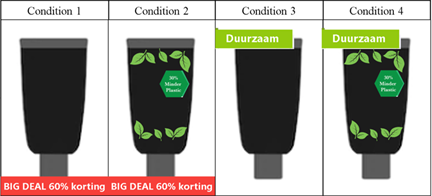KIDV continues as Verpact
November 6, 2025
So-called packaging and webshop cues actually stimulate the sustainable purchasing behaviour of consumers. Consumers value sustainable packaging and they also spend more money on products in a sustainable packaging. This is the outcome of a study by Esther Daams, master's student in psychology at the University of Groningen, commissioned by the KIDV.
To help consumers make sustainable choices, producers and, for example, web shops can put cues on packaging, such as eco-labels and 'natural' elements. They can also add sustainability labels to the articles in their web shops. Earlier research by the KIDV showed that there are several ways to communicate the sustainability of packaging through the packaging. Daams built on this with her research: "I was curious about the effects of packaging and webshop cues in a realistic setting. Do they really lead to more sustainable purchasing behaviour? To investigate this, for my graduation internship I entered into a collaboration with an anonymous drugstore via the KIDV. We created a replica of their webshop and let as many participants as possible use it."
The almost 300 participants were not instructed in advance as to what the research was about. They had to choose a certain amount of products in the webshop and then Daams analysed their behaviour. Participants were randomly assigned to one of four webshop conditions (see figure 1). They were shown twenty products, with or without a packaging cue (eco-label and nature elements) or a discount label or a sustainability label. After their selection ('purchase') of the products, the participants could choose between two options for shipping: one-way shipping packaging or reusable shipping packaging with a 4.95 euro deposit. Finally, a questionnaire measured their intention to choose sustainable delivery options.

Figure 1 Examples of the webshop and packaging cues
The experiment showed that consumers spend more money on sustainable products when they see packaging or webshop cues. "Surprisingly, however, combining these cues is counterproductive: when both packaging and web shop cues are shown, consumers spend less money on a (more) sustainable option," says Daams. She also found that communication on packaging about sustainability does not automatically lead consumers to choose the most sustainable packaging when purchasing a product.
Daams: "More sustainability signals are not guaranteed to lead to more sustainable purchasing behaviour. Perhaps this overkill of information actually causes consumers to doubt the true sustainability of a product or packaging. It is therefore important that organisations only use sustainability cues when they are actually sustainable."
In terms of delivery options, no direct relationship was found between the choice of products with sustainable packaging and webshop cues and the intention to have the next package delivered in a sustainable manner. Daams does note, however, that the option with cues on the reusable delivery option itself was not investigated. Stimulating this option could possibly be effective. What the study does show is that fifty per cent of respondents would choose reusable packaging, even if it costs €4.95 in deposits and the consumer has to go to extra lengths to return the packaging. Daams: "So it is certainly relevant for organisations to create sustainable options; consumers are generally very open to these initiatives."
According to Daams, not all sustainable packaging cues are equally effective for all products. "Consumers evaluate the sustainability of a product by the total product-packaging combination. In this study, several products have received sustainable packaging and web shop cues. Due to the form of the study, it was not possible to find out whether they were more effective for some packaging than others."
Click here to read the full study.
